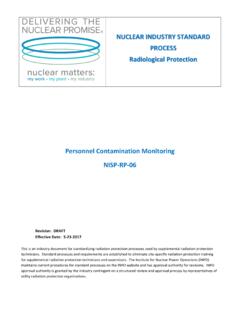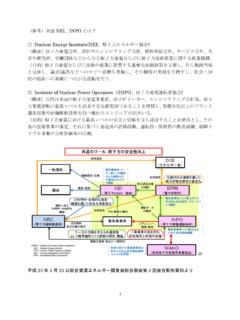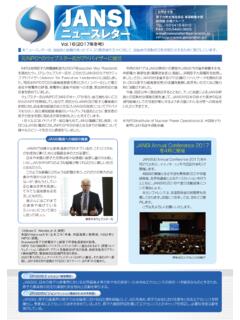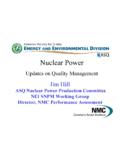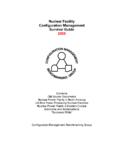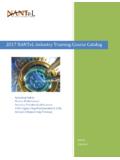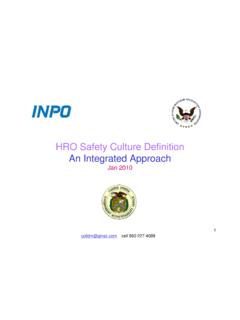Transcription of NUCLEAR INDUSTRY STANDARD PROCESS …
1 Portable Survey Instruments NISP-RP-01 Revision: 0 Effective Date: 10/28/2017 This is an INDUSTRY document for standardizing radiation protection processes used by supplemental radiation protection technicians. STANDARD processes and requirements are established to eliminate site-specific radiation protection training for supplemental radiation protection technicians and supervisors. The Institute for NUCLEAR Power Operations (INPO) maintains current procedures for STANDARD processes on the INPO website and has approval authority for revisions. INPO approval authority is granted by the INDUSTRY contingent on a structured review and approval PROCESS by representatives of utility radiation protection organizations.
2 NUCLEAR INDUSTRY STANDARD PROCESS Radiological Protection NUCLEAR INDUSTRY STANDARD PROCESS Portable Survey Instruments Document #: NISP-RP-01 Revision: 0 Effective Date: 10/28/2017 Table of Contents Introduction .. 1 Purpose .. 1 Scope and Applicability .. 1 General Requirements .. 1 PROCESS Instructions .. 2 Perform Pre-Use Instrument Inspections and Checks .. 2 Operate an Ion Chamber Survey Instrument .. 2 Operate a GM Survey Instrument .. 3 Operate a Count Rate Meter with a GM Frisker Probe .. 3 Operate a Count Rate Meter with an Alpha, Beta, or Dual Scintillation Probe .. 3 Operate a Neutron Rem-meter .. 4 Clarifying Notes .. 4 References .. 4 Attachment 1: General Radiation Detector Types and Uses.
3 5 Attachment 2: Typical Portable Detection Systems in Use at NUCLEAR Power Stations .. 7 NUCLEAR INDUSTRY STANDARD PROCESS Portable Survey Instruments Document #: NISP-RP-01 Revision: 0 Effective Date: 10/28/2017 Page 1 of 12 Introduction Purpose This procedure provides basic instructions to operate common instruments used for radiation and contamination surveys. General descriptions, operating characteristics and limitations of these instruments are provided as attachments. Scope and Applicability This procedure provides guidance for the selection and operation of portable instruments that measure gamma, beta, alpha and neutron radiation. If supplemental personnel are expected to operate instruments beyond the scope of this procedure, additional training may be required consistent with the site training and qualification program.
4 This procedure will be used to train supplemental radiological protection technicians. Current revisions are maintained on the INPO website. Terms, acronyms, and definitions are provided in NISP-RP-13, Radiological Protection Glossary. Clarifying notes for requirements and PROCESS steps are provided in Section using superscript numbers in the preceding sections. General Requirements Ensure that selected survey instruments are appropriate and calibrated to detect the types of radiation present in the work area. Ensure that instruments used to measure radioactivity count rate have a scale that reads in units of counts per minute (cpm) or a multiple of this unit. Ensure that instruments used to measure gamma dose rate have a scale that reads in units of mR/hr or mrem/hr or a multiple of these units.
5 Refer to Attachment 1, General Radiation Detector Types and Uses for general information on instrument types and use. Refer to Attachment 2, Typical Portable Radiation Detection Systems in Use at NUCLEAR Power Stations to obtain specific information about STANDARD portable detection systems. Read all tags and labels on an instrument to determine if the use of a scale is restricted. When using an instrument model for the first time, review the applicable manufacturer technical or operational manual, or operating procedure to understand the data display, control adjustments, and limits. Ensure the instrument is turned on prior to entering an area to survey. Zero the instrument, if applicable, prior to entering the radiationfield.
6 Prevent contamination of an instrument by avoiding contact with contaminated surfaces or bagging the instrument prior to use in a contaminated area. Prevent damage to thin window detectors by avoiding contact with small, sharp objects. Apply appropriate correction factors as provided by site procedures. NUCLEAR INDUSTRY STANDARD PROCESS Portable Survey Instruments Document #: NISP-RP-01 Revision: 0 Effective Date: 10/28/2017 Page 2 of 12 When using an instrument with an internal detector, use case markings to align the detector with radiation sources. When using an instrument with an analog meter, allow the meter to recover/stabilize from inertial effects on the needle. If the instrument has a scale adjustment, set the instrument on a scale appropriate for the expected dose rates prior to exposing the instrument to the radiation field.
7 Adjust scales with the objective to obtain a stabilized reading between 10% and 90% of the scale. Allow the meter to stabilize after switching scales due to the potential for electronic noise to cause a temporary meter deflection. If radiation levels are < 10% of the lowest scale, consider the radiation levels to be lower than the minimum sensitivity of the instrument and therefore a meter with a more appropriate range meter scale should be used Prevent instrument damage by avoiding exposure to excessive heat, moisture, and radiation fields that are significantly above full- scale of the instrument. PROCESS Instructions Perform Pre-Use Instrument Inspections and Checks.
8 Inspect instruments for physical damage prior to and during use. Ensure all cables are connected securely; verify no spikes or erratic results are displayed when moving cables. Ensure switches and knobs can be operated without restriction. If using a scintillation detector, turn the instrument on and check for punctures in the detector window by exposing the detector to a light source. An increase in the background count rate may be indicative of a punctured window. If damage is suspected, tag the instrument out of service and contact appropriate site instrument coordinator or supervisor. Ensure the instrument has a calibration sticker affixed and that the calibration due date is in the future.
9 If the instrument has a Battery Check mode, perform a battery check and ensure that the reading is within the specified range. When inspecting an instrument with an analog or digital meter: Ensure a source check per the required frequency has been performed on the scales expected to be used. When performing source checks, use the identified source. If the site uses an instrument accountability system, sign instruments out and in as appropriate. Operate an Ion Chamber Survey Instrument NUCLEAR INDUSTRY STANDARD PROCESS Portable Survey Instruments Document #: NISP-RP-01 Revision: 0 Effective Date: 10/28/2017 Page 3 of 12 Determine the gamma dose rate by holding the instrument in a steady position with the window closed and allowing the readout to stabilize.
10 Determine the beta dose rate by obtaining open window and closed window readings with the instrument in the same position. Apply the following calculation: = ! where: WO= Window Open WC= Window Closed CF = Beta Correction Factor (provided on an instrument label or in site procedures) Measure the activity on a highly contaminated smear ( > 100,000 dpm) by placing the open window as close as possible to the smear without touching it and observe the digital display or meter indication. Apply correction factors as provided by site procedures as needed to convert readings to dpm/100 cm2 ( 75,000 dpm/mR per hour of Cs-137). Operate a GM Survey Instrument Determine the gamma dose rate by holding the instrument in a steady position and allowing the display to stabilize.
